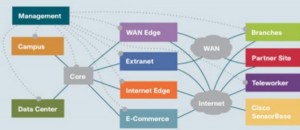Data Center LAN Solutions

Data Center LAN Solutions
In this post we are going to focus on what are the possible Data Center LAN Solutions and how should we apply them. More precisely, we will be looking at the solutions for our case study; a Data Center for a well-known banking firm, and using all the possible equipment of our chosen LAN manufacturer: Extreme Networks.
In the Network level our Data Center must fulfill a great number of requirements. Those are:
- High redundancy.
- Isolation between data, services and Internet.
- Spanning-tree elimination (because it block up to 50% of the links).
- Service balancing at transport level.
- 10GB Ethernet links, and equipment able to work at 40-100 GB in the future.
In order to meet those requirements we will need to use some protocols that are well-known among data center designers. Moreover, we will also need to describe the architecture of our Data Center and to start thinking about specific equipment we will be using.
Data Center design with Building Blocks
An important idea we got from this week’s lecture, by David Angulo, has been the recommendation to design our Data Center using Building Blocks, with different and separate uses, to help building and maintain our infrastructure.
This design will provide us with the desired isolation (requirement 2).
In the next image we can see a possible division of a typical Data Center:
Trill / FabricPath
This two protocols have lately become mainstream in Data Center designing, due to their ability to provide a flat core network that is easily scalable, manageable, and configurable, while providing an efficient link usage. It’s worth noticing that Trill is the IEEE standard for the Cisco’s protocol FabricPath.
In a time where server virtualization is rapidly increasing East-West traffic in front of the usual North-South, a protocol that allows us to expand our Data Center horizontally and disables the need of STP (requirement 3) is nearly mandatory. New Generation Data Center designers should always think about implementing one of this two solutions (depending on the manufacturer of the equipment) unless they are using other new solutions, like SDN. It also provides our links with the ability to balance load (requirement 4).
Here is a link to a User Guide for Extreme Network’s equipment’s operative system. In page 641 you will be able to increase your knowledge on how to implement Trill on this manufacturer’s equipment.
Data Center LAN Equipment
Using the philosophy shown in page 644 of the Extreme Network’s pdf, we have decide to use BlackDiamond X8 Switches for the core of our Data Center, the number of those will vary depending on the traffic estimation we will do in a near future.
For our Top-of-Rack switch we could use either Summit X670 series or Summit X770. Our initial choose will be the X770 series, because of its ability to work also on 40GB; a speed we could be needing in not a long time (requirement 5).
Finally, as we can see in the image below, we will be using lots of redundancy to avoid single points of failure (requirement 1).
To summarize, in this post we have seen how we are going to fulfill most of our Data Center LAN requirements of our banking firm project. Nevertheless, we still need to define some service we haven’t talked about yet, how are we going to define the building blocks, how are we going to implement the pre-production network and to do the final implementation and decision of the LAN equipment. Sadly, all this will be treated in another post.
Keep tuned to this blog for more Data Center LAN Solutions!



Add new comment